Mixed Bag Vol. 11
A journey among less typical shores and grapes.

The story is as ancient as time itself, perhaps even older, for in the beginning there was only a backpack. The contents of this mysterious backpack are unknown, yet spiritual leaders from various faiths agree on one detail: it was from this backpack that a divine being emerged—born solely from the foam of sparkling wine-like Venus but more realistic. True to the teachings of Mr. Skovoroda, like a diligent Herodotus of winefulness, I conscientiously carry sacred bottles in my backpack. The well-known theme here is the unyielding fate of what I might pull from it, yet the final selection wholly depends on the company gathered. So here's another interpretation of 'Mixed Bag.'
I must admit, I genuinely enjoy this format. There's a core theme—this time, wines from Japan—which I'm eager to share, and I tailor the rest to suit both the theme and the attendees. For some, I might add a sparkling or an orange wine. For others, I'll swap out a particularly bold bottle for something more accessible, and for yet another, I aim to challenge their palate and perspectives. It's not as straightforward as it sounds, and while it might come off as poetic, I do put in the effort.
What's the underlying theme of this gathering? Uncommon locales, grape varieties, or interpretations—with a preference for more gentle reds. Japan, with its relatively long history of winemaking, is a point of intrigue as everything is new to us here. 'Post Flirtation Red' showcases Martha Stoumen's vision of the Zinfandel variety, which we seldom indulge in. 'Sadie Family' represents the world's finest Cinsault and an incredibly delicate Grenache. 'Se Kwa Sa' is about a multitude of indigenous varieties, perseverance, and change. Lastly, 'Momento Mori' reflects my attempt to bring an orange wine from Australia that turned out to be red—I was unaware, just like Good Wine employees, that there are two versions of this wine, hence they dubbed the red Syrah as 'white Ribolla'—such are the surprises.
With these thoughts, we gathered on a Monday to embark on a journey around the world. And here are the results of that venture.
Related posts
- Se Kwa Sa? – A Buronfosse wine tasting by Ivan Omelchenko.
- Heaven and Earth – Wave of revolution! Three stars of South African wine scene.
- Atypical ver.1.22474487139... – A wine tasting event dedicated to atypical combinations of location and grapes.
Frumushika-Nova Citronniy Magaracha Rose Brut Traditional Method 2022
- Region
- Ukraine » Odesa Oblast
- Type
- rose traditional sparkling, brut
- Producer
- Vintage
- 2022
- Disgorged
- N/A
- On lees
- N/A
- Grapes
- Citronniy Magaracha
- Alcohol
- 13.5
- Volume
- 750 mL
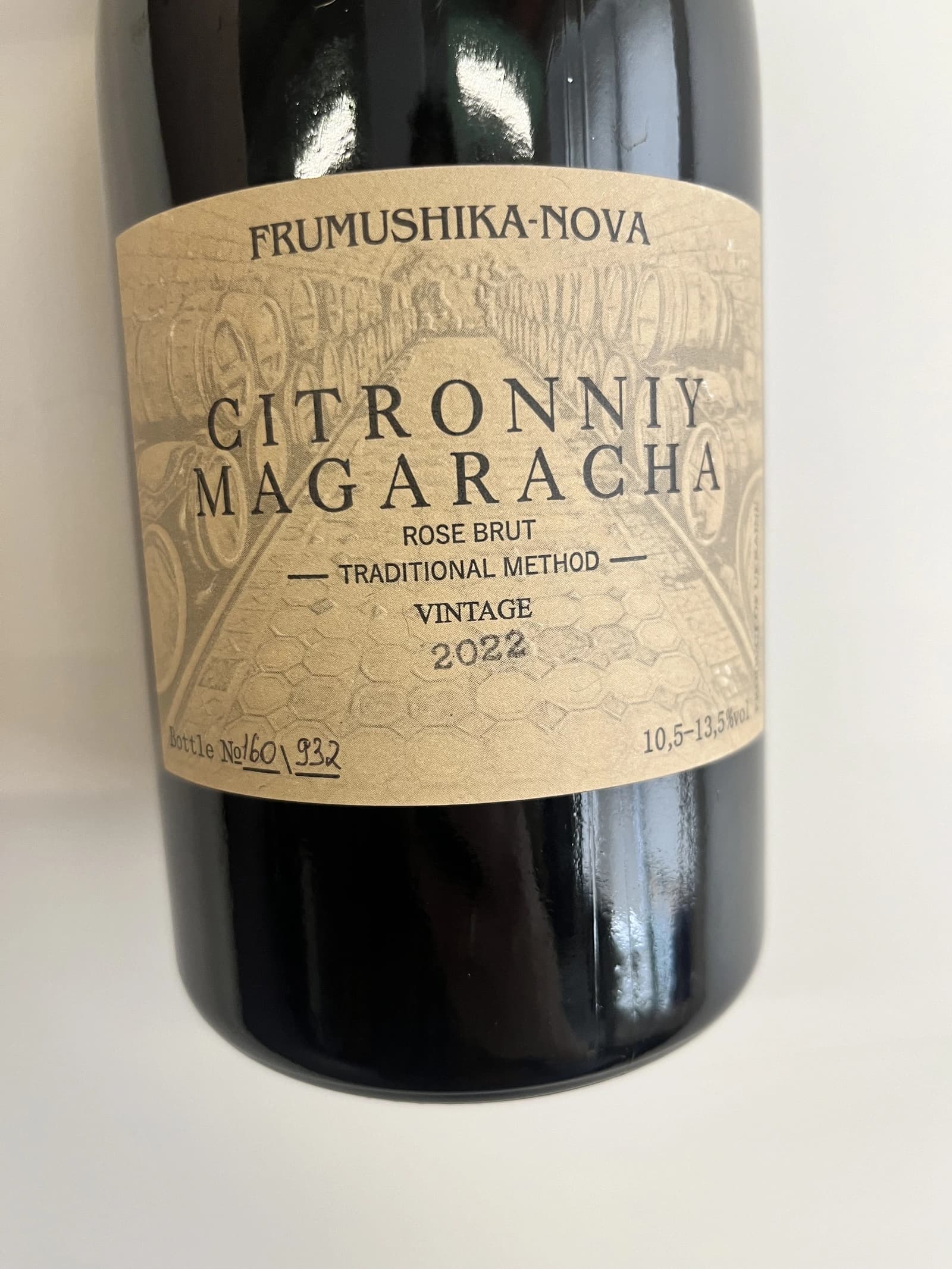
This wine secured the 🏅 8th place in our wine tasting lineup.
This was just a welcome drink.
Hitomi Winery Malodela 2020
- Region
- Japan » Shiga Prefecture
- Type
- white still, dry
- Producer
- Wine
- Vintage
- 2020
- Grapes
- Delaware
- Alcohol
- 12
- Volume
- 750 mL
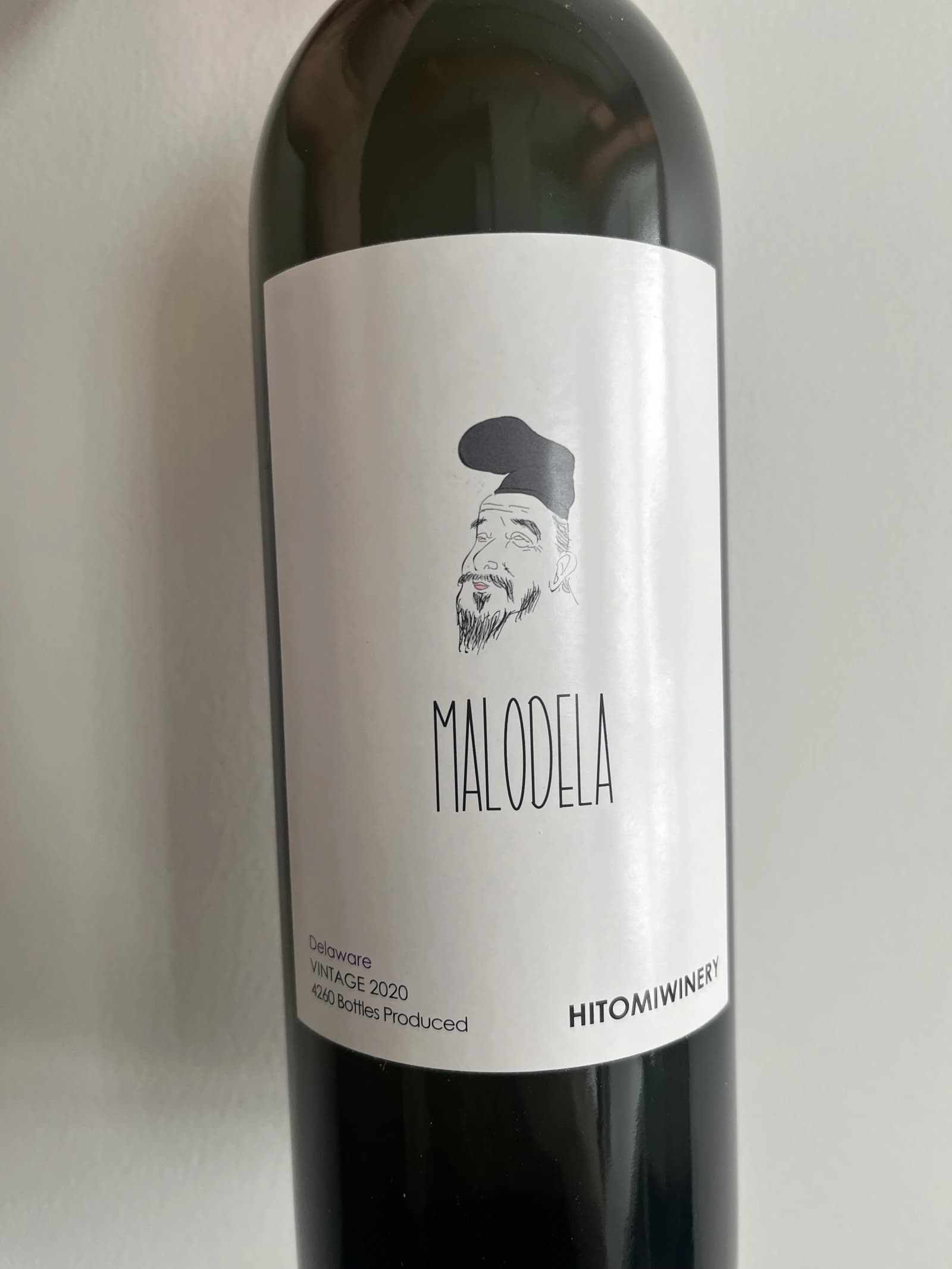
This wine secured the 🏅 7th place in our wine tasting lineup.
Hitomi Winery, a Japanese wine producer, is situated on the eastern shores of Lake Biwa, Japan's largest lake, located in the central region of the country. Established over 25 years ago by a Japanese fashion designer who decided to pursue his true passion, the winery has flourished into a respected name in the wine industry.
Today, Hitomi Winery embraces organic practices and produces around 40 different cuvées, all released in limited editions.
Grape Republic Rosso 2019
- Region
- Japan » Nihon Wine (日本ワイン)
- Type
- red still, dry
- Producer
- Wine
- Vintage
- 2019
- Grapes
- Steuben, Yama Sauvignon, Niagara
- Alcohol
- 10.5
- Volume
- 750 mL
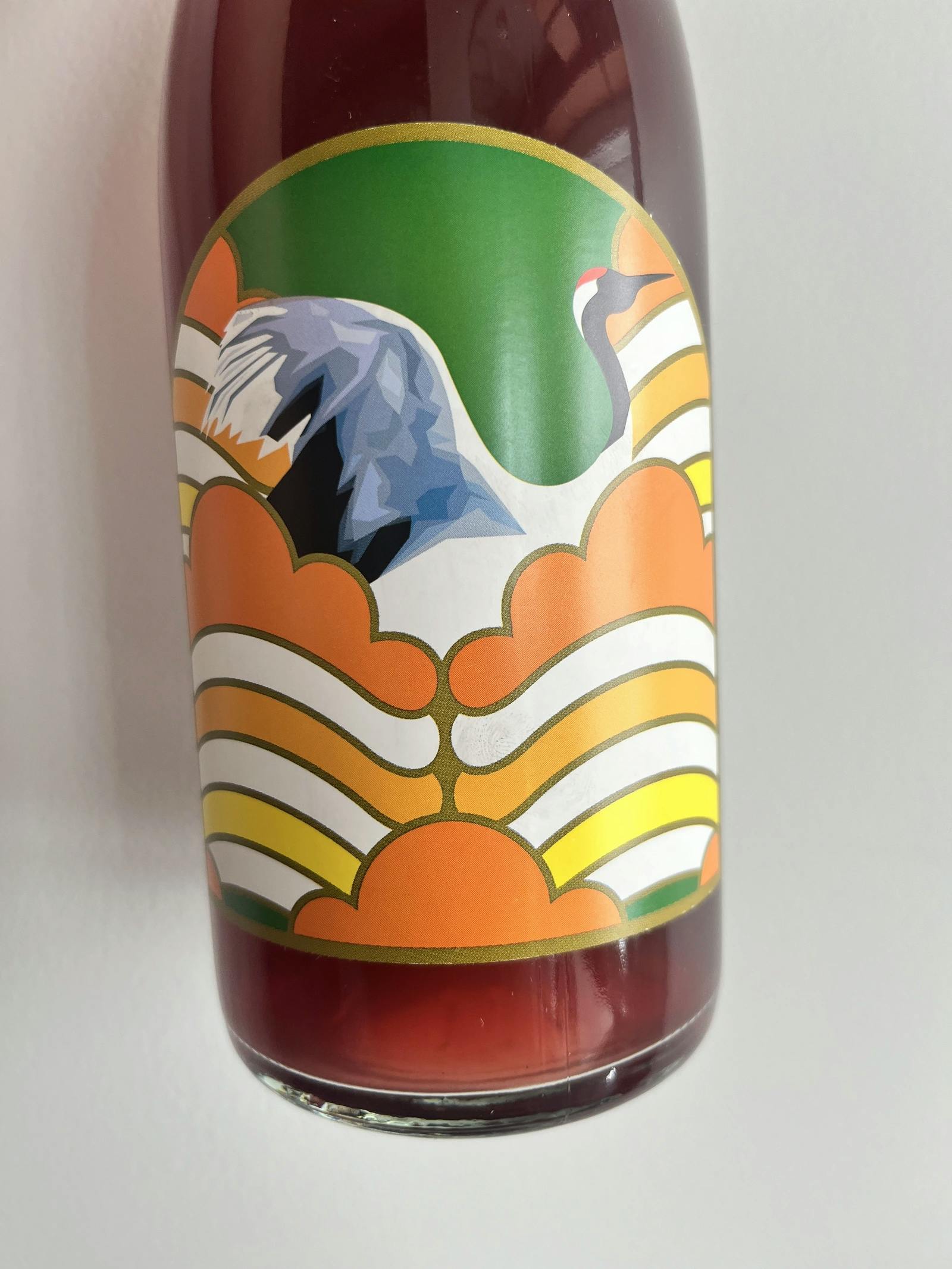
This wine secured the 🏅 5th place in our wine tasting lineup.
Originally a restaurateur and sommelier, Kazuomi Fujimaki took a significant leap in 2015 by leaving Tokyo to become a winemaker in the village of Shinden in Yamagata. With no prior experience in wine production, he established three simple rules for himself: the vineyards must be cultivated organically, no additives such as sulfur are to be used during the winemaking process, and the wines must at some point undergo amphora fermentation or ageing. His goal with Grape Republic is to create vibrant and pure Japanese wines naturally, utilizing indigenous grape varieties grown around the Yamagata region.
Central to Fujimaki’s philosophy is the expression of terroir in his wines, encompassing not only the climate, geography, and soil but also the local culture and people. The vineyards and winery are located in Nanyō City, Yamagata Prefecture, where the northern slopes provide fertile ground that stretches southwards. Although the area is well-suited for viticulture, it remains largely underutilized by other winemakers—a situation Fujimaki is determined to change by demonstrating the potential for high-quality grape cultivation and natural winemaking, thereby inspiring other vintners to settle in the region.
Grape Republic’s natural wines are made exclusively from grapes harvested around Nanyō City, with a strict zero-zero approach—no chemicals such as fertilizers, pesticides, herbicides, or insecticides are used on the land, and no additives like sugar or acid are introduced in the cellar. Production, though small at 30,000 bottles annually, is steadily increasing. From just 100kg of grapes processed in its first harvest year of 2015, collaboration with local farmers boosted this to about 40,000 kg by 2017. The aim is to continue expanding production, partly to encourage more local farmers to engage in winemaking.
2017 also marked the year Grape Republic completed its professional cellar. A significant number of Spanish amphorae were installed, playing a crucial role in the fermentation processes. After harvesting, the grapes are destemmed and foot-trodden before being placed in the amphorae, which are sealed to facilitate most of the ‘carbonic maceration’ fermentations.
The 2019 Ross combines Steuben (81%) and Niagara (4%) varieties from Yamagata, known for their fruitiness, with Yama Sauvignon (15%) from Iwate, appreciated for its crisp acidity. The Steuben grapes undergo skin fermentation for 4 to 6 days, enhancing their inherent floral notes, while the Yama Sauvignon is fermented on the skins for 12 days, adding depth and a hint of robustness to the wine.
Martha Stoumen Post Flirtation Red 2018
- Region
- USA » California » Sonoma
- Type
- red still, dry
- Producer
- Vintage
- 2018
- Grapes
- Zinfandel, Carignan
- Alcohol
- 12.3
- Sugar
- 1
- Volume
- 750 mL
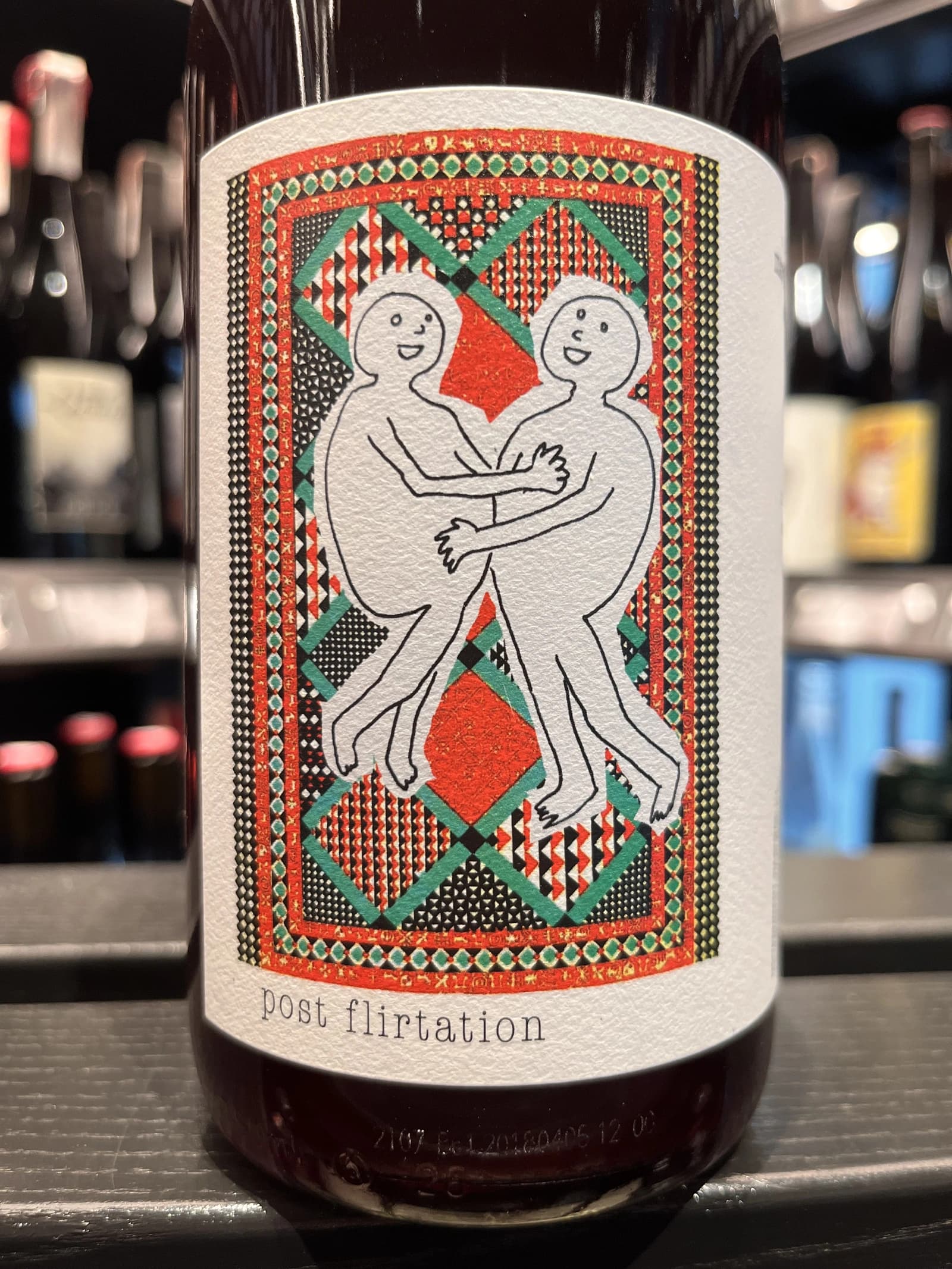
This wine secured the 🥈 2nd place in our wine tasting lineup.
A classical Californian blend of Zinfandel and Carignan. The former comes from Del Barba Vineyard, Contra Costa County. This dry-farmed vineyard was planted in 1960 and grown without pesticides and herbicides. Carignan comes from certified organic Ricetti Vineyard in Mendocino County. It was planted in 1948 and is also dry-farmed.
This wine is so joyous, and to me, distinctly Californian. I never knew how much I loved Zinfandel until I started working as Chris Brockway’s (Broc Cellars) Assistant Winemaker. When picked before the grape berries begin to shrivel, you get these amazing hibiscus, rhubarb, pomegranate, and baking spices from Zin. Like an avocado, the window is small between unripe and overripe for Zin, and I watch this vineyard closely. Carignan, Zin’s less celebrated companion, provides a savory component reminiscent of driving through California chaparral, and, like Ricetti’s, can be incredibly complex with 70 years of vine age. I’m not re-inventing the wheel with this classic old vine Zin/Carignan blend, just lightening things up a bit.
Buronfosse [Se Kwa Sa?] 2022
- Region
- France » Vin de France
- Type
- red still, dry
- Producer
- Wine
- Vintage
- 2022
- Grapes
- Poulsard, Pinot Noir, Trousseau, Gamay, Béclans, Enfariné Noir, Tinturiers
- Alcohol
- 11
- Sugar
- 2
- Volume
- 750 mL
![Buronfosse [Se Kwa Sa?] 2022](/_next/image?url=%2F_next%2Fstatic%2Fmedia%2FIMG-2057.3012b47e.webp&w=3840&q=75)
This wine secured the 🥉 3rd place in our wine tasting lineup.
Buronfosse are the exemplary tale of city slickers yearning for rustic tranquillity, swapping urban chaos for country serenity to cultivate vegetables, care for animals, and forgo the relentless bustle. Initially, winemaking wasn't on Peggy and Jean-Pascal Buronfosse's agenda when they moved to La Combe de Rotalier in 1999. Jean-Pascal took up teaching, while Peggy, leveraging her agricultural expertise, joined Jean-François Ganevat's vineyards – a legend now enshrouded in controversy in Ukraine due to ties with moscow's oligarchs. In 2000, Raymond Pageault, a venerable local vigneron, entrusted his vineyards to Peggy, thus planting the seeds for their quaint wine domaine.
Peggy gradually phased out herbicides, embracing organic farming by 2007. By 2013, Jean-Pascal left teaching to devote himself entirely to the domaine. Today, the couple nurtures around 4.5 hectares of land, growing not just Chardonnay, Savagnin, and Pinot Noir, but also a host of lesser-known indigenous varieties.
Their story is compelling, but tasting their wines is where the true intrigue lies. Buronfosse wines are marked by a pristine and elegant style, free from any 'funk and rock 'n' roll'; yet still carrying a distinct character. I deeply respect winemakers who practice minimal intervention yet achieve such discipline and clarity. It's all too easy to mask flaws under the guise of 'naturalness'. Buronfosse's journey is fascinating; from their earlier, somewhat reductive and untamed wines to today's embodiment of elegance and finesse. While not revolutionary, their wines are irresistibly tasty and captivating – the kind you'd happily savour again and again. To me, wine is, foremost, a culinary delight, and I treasure wines that excel in both approachability and enjoyment.
A blend of Poulsard, Pinot Noir, Trousseau, Gamay, Béclans, Enfariné, and Tinturiers, biodynamically grown on 0.70 hectares of calcareous clay and marl soil. The 70-year-old vines produce a wine that's spontaneously fermented in neutral oak, aged 10-12 months, with no fining, filtration, or added .
The text is stolen from Se Kwa Sa?
Sadie Family Soldaat 2022
- Region
- South Africa » Western Cape » WO Citrusdalberg
- Type
- red still, dry
- Producer
- Wine
- Vintage
- 2022
- Grapes
- Grenache
- Alcohol
- 13
- Sugar
- 1.8
- Volume
- 750 mL
- Find at
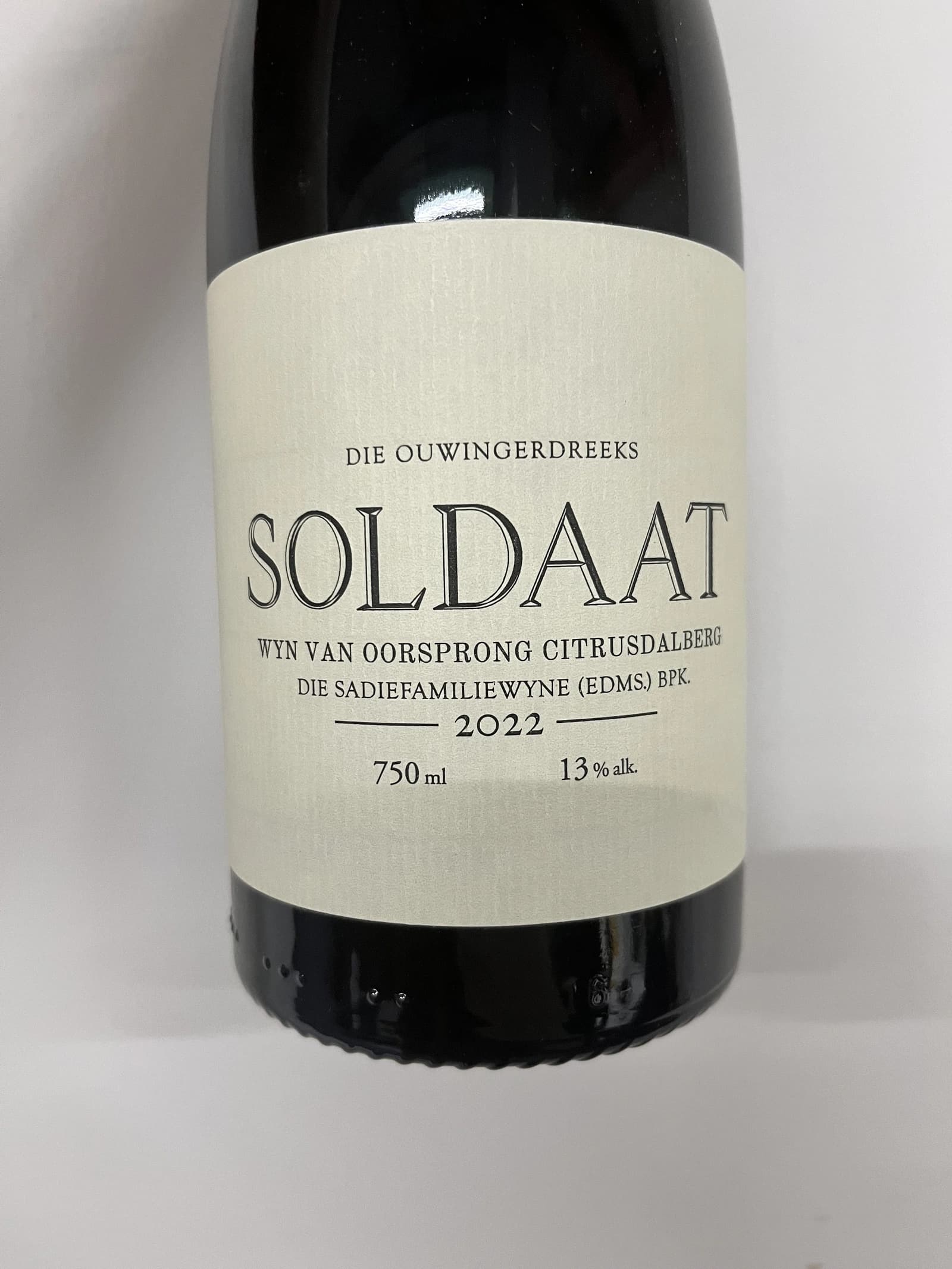
This wine secured the 🏅 4th place in our wine tasting lineup.
Eben Sadie from The Sadie Family Wines is a true legend in the world of winemaking. He has a fascinating story that has taken him all over the world, honing his craft and learning from the best. Eben graduated from Elsenburg College in 1994 and began his journey throughout Germany, Austria, Italy, France, Spain, the United States, and South Africa, always seeking to learn and improve his skills.
Re-evaluation of Swartland began in the late 1990s when Charles Back of Fairview set up the Spice Route. In 1998, Eben joined Spice Route as head winemaker. During his time there, he gained valuable experience and developed his style. Eben was quick to realise Swartland's potential and, in 2000, produced his groundbreaking Syrah-based blend, Columnela.
Over the years, Eben has built a reputation for crafting exceptional wines that truly showcase the unique terroir of the Swartland. His passion for winemaking and dedication to quality has earned him numerous accolades, including being named Winemakers' Winemaker in 2017.
If you look at old wines from the Swartland you'll realise that we don't really have to reinvent anything, we should just go and harvest the good, old things that were already there. The Swartland really is one of those places where you can say what we have is fantastic, what we have is enough – there is nothing better out there. Our soil is remarkable and while our climate is a bit tough at present due to the drought, this place is thoroughly amazing.
— Eben Sadie
In addition to his stellar Columella and Palladius blends, Eben is renowned for his Old Vine Series, which he started working on in the second decade of the winery's life. The Old Vine Series consists of eight distinct wines - Skurfberg, 'T Voetpad, Pofadder, Kokerboom, Mev. Kirsten, Soldaat, Treinspoor, and Skerpioen. The grapes are sourced from some of the oldest vineyards in South Africa, located throughout the Swartland, with one or two falling outside the region's official borders.
Grenache, historically one of the most planted red varietals in South Africa, is experiencing a resurgence with many new vineyards being planted recently. Young Grenache vines tend to be overly productive, which previously led to quality issues. However, mature vineyards or those planted in challenging sites produce less fruit but of higher quality, allowing them to produce wines that can rival the elegant and refined reds from Mediterranean climates.
The vinification process involves filling the concrete tanks with 60% whole clusters and 40% destemmed grapes to initiate fermentation. This process lasts about 30 days on the skins, followed by pressing using an old basket press.
Post-pressing, the wine is transferred back into 33Hl concrete tanks for ageing. It spends eight months on the lees, followed by a transfer to another concrete tank for an additional four months to settle. Three weeks before bottling, 60mg/L of sulphur is added, and the wine is then bottled from the fine lees.
Sadie Family Pofadder 2022
- Region
- South Africa » Western Cape » WO Swartland
- Type
- red still, dry
- Producer
- Wine
- Vintage
- 2022
- Grapes
- Cinsault
- Alcohol
- 13.5
- Sugar
- 1.5
- Volume
- 750 mL
- Find at
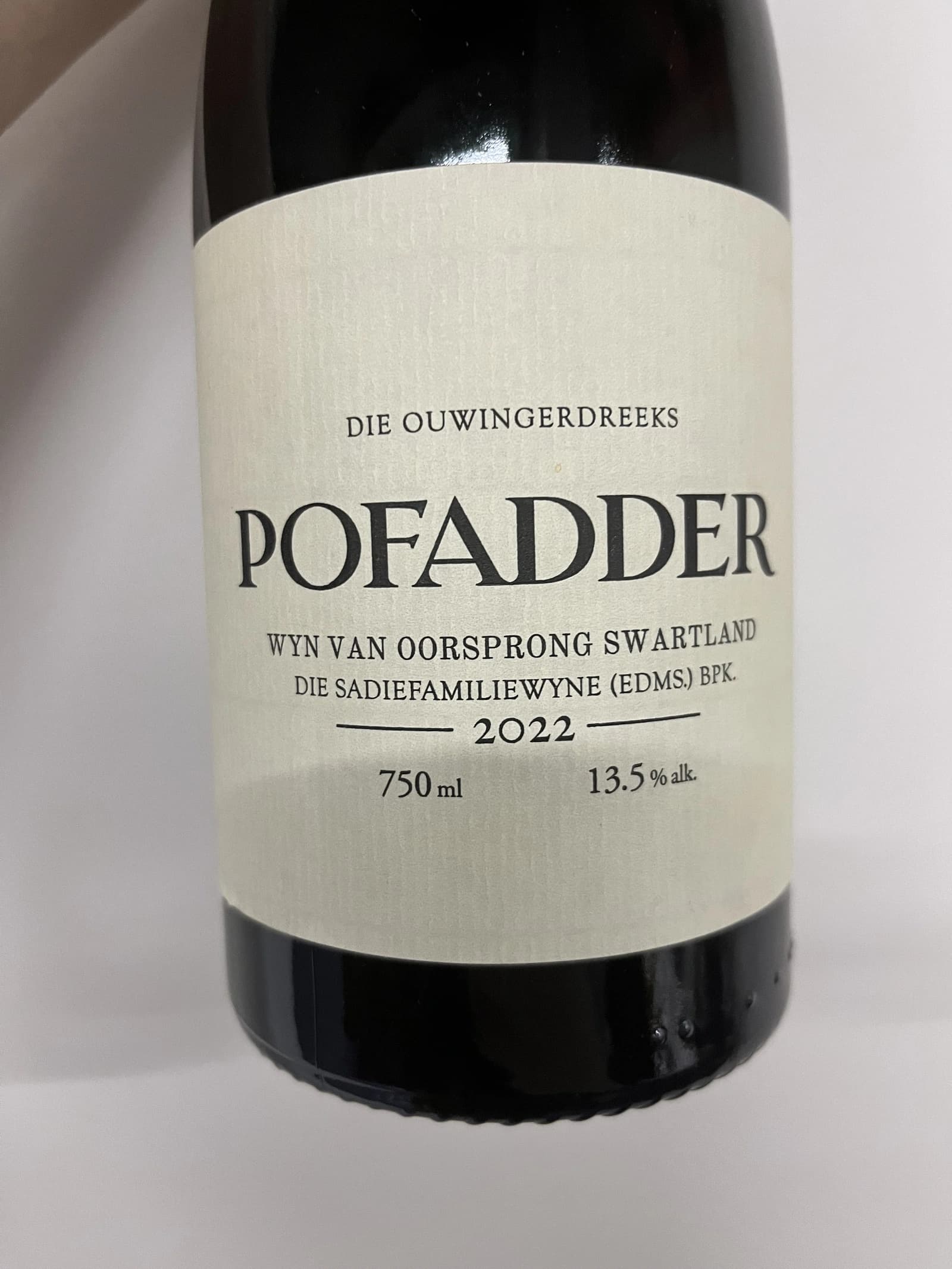
This wine secured the 🥇 1st place in our wine tasting lineup.
Historically, throughout the late 19th and much of the 20th century, Cinsaut served as a crucial yet understated component in many of South Africa's prestigious red blends. Known for its challenges, including maintaining low yields and achieving optimal ripeness, Cinsaut requires meticulous management both in the vineyard and during vinification due to its oxidative nature. The vinification process begins with filling the concrete tanks with 50% whole clusters and 50% destemmed grapes to initiate fermentation. This lasts approximately 30 days on the skins before the wine is pressed using an old basket press.
Post-pressing, the wine matures in 28-year-old conical wooden casks that do not impart any woody flavors. The age and saturation of these casks allow for a very gradual oxidative process. The wine spends 11 months on the lees, then is transferred to a concrete tank for an additional month to clarify. Just two weeks before bottling, 60mg/L of sulphur is added, and the wine is then bottled from the fine lees.
Momento Mori Amphora 2021
- Region
- Australia » Gippsland
- Type
- red still, dry
- Producer
- Wine
- Vintage
- 2021
- Grapes
- Syrah
- Alcohol
- 12.5
- Sugar
- 0
- Volume
- 750 mL
- Find at

This wine secured the 🏅 6th place in our wine tasting lineup.
Momento Mori is a small-scale winery in Gippsland, Victoria (Australia). The team consists of New Zealander Dane Johns, his wife Hannah and a few friends. They farm vineyards using strict organic principles, but sometimes, they source grapes from like-minded growers throughout Victoria. All wines are made with minimal intervention - small ferments, no oak, no additives.
Farming and winemaking philosophy comes behind the result. At least, this is how I prioritise these things. When I only started to learn about non-conventional wines, I stumbled upon enough ill-made wines to make me cautious about winemakers placing philosophy over resulting wine. Low-intervention is not as easy as it sounds.
Momento Mori was among those winemakers that I didn't like at first. Luckily, I learned that their wines require some time to settle down. That's why I am happy that the team can now afford to age their wines in bottles before releasing them to market.
Aside from a punny name (with a notable change of a single litter) and catchy labels, the winery is famous for cultivating Meditterian grapes in Australia (the one with kangaroos). Greco di Tufo? Fiano? Schioppettino? Vermentio? Moscato Giallo? Let's be honest. Some of these grapes are infrequent even for Italian winemakers. And we are talking about Australia!
That was meant to be macerated blend of Ribolla Gialla and Fiano, but it turned out to be a red Syrah. That happens, I guess. At least it was funny.